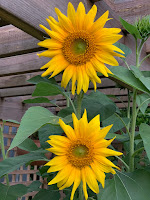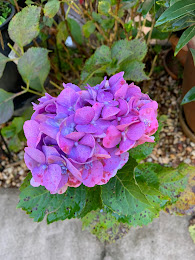Funerals and Christmastime don't make for a good mix. But I'm just back from Brisbane where I had the sad experience of helping to farewell John Hazelwood - my son-in-law Brandon's father, and part of my extended family for almost 20 years.
 |
| Hazelwood-Boulanger family (March 2020) |
In a great speech at their wedding, John told the story of how he met Zoe:
It was at around 2am one morning and I had just reversed the car and boat into the driveway at home after a thirteen hour trip. I had just been up to North Qld. for a couple of weeks fishing. As I was heading inside to get the keys to open the side gate, the front door opened, “Hi John, I’m Zoe” There in the doorway was this angel. I thought, Oh no I’ve run off the road and killed myself and I am now in heaven. Just then a voice said “Hi Dad”. It was Brandon opening the side gates for me. I quickly came back to earth and thought, Heyyyy Boy you have certainly lifted your game.
 |
| John meets Charlotte Maudie H. |
A few years later, Brandon and Zoe gave us a grandchild: Charlotte Maudie Hazelwood, or Charlie. That middle name 'Maudie' was the name of Brandon's Mum, who had died not long before Brandon and Zoe met. John was deeply touched by their giving Charlie that name.
From the time Zoe and Brandon met, John and I along with my late husband had become the official family elders at all our family gatherings: Christmases, birthdays, anniversaries etc. It took a while for us to feel comfortable with each other - we had very different backgrounds and life experiences and (I suspect) views about a lot of issues - though we always avoided straying into problem areas out of mutual respect.
 |
| A Christmas gathering of the Harvey-Boulanger-Hazelwood clan. My stepson Julian (standing next to his father) was celebrant at John's service. |
John's and my friendship deepened when I became a carer - first for my mother, and then more intensively for my late husband. Caring for an ill spouse was something John was all too familiar with.
John was born in August 1945, so he was just six months younger than me - a sobering thought when you go to a funeral.
 |
| Sniper Hazelwood |
He was the eldest of four children. His sister Pam and brother Ken still live in New South Wales, where John grew up; another brother Neville died in infancy. John completed an apprenticeship in Sydney as a carpenter/joiner. and played rugby there too.
.JPG) |
| John with brother Ken and sister Pam |
His number turned up in the National Service lottery, but he narrowly avoided going to Vietnam as a sniper. Luckily for him, an eardrum was damaged during the medical so he was discharged.
He had two children - Shayne and Mark - with his first wife Helen, but when that marriage ended he went north and worked on a prawn trailer. Then, back in Sydney, he met Maudie and for a while lived the tough life of a professional fisherman. He was a one-man operation, towing his boat late at night through Sydney to Pittwater where he would either head up the Hawkesbury River or out to sea. On his return he would drop the fish off at the markets and head home for a well earned sleep.
 |
| John and Maudie |
In 1977 the couple moved to Queensland, where Maudie had grown up. But even before Brandon was born two years later, she'd had one brain tumour removed. Another was detected while she was pregnant and the operation to remove it left her with cerebral palsy - not an easy diagnosis for a new mother. Maudie lived until 2002 - long enough to see her son into adulthood. But it had been a long, hard road for them all, given the sad effects of brain cancer.
 |
| With a barramundi at one of his Proserpine visits |
Throughout his life, fishing was John's anchor point. As Brandon said in John's eulogy, "What he didn't know about fishing wasn't worth knowing." Brandon continued:
Once he moved up to Queensland and I was born things were a bit more difficult and his boat didn’t leave the driveway again for many years. When I got older his passion for fishing came back and we spent a lot of time fishing together. He joined a group of Barra fisherman up Proserpine way and drove his boat up the highway every year for a number of years to fish their invite-only Barra competition. While he never won, he caught a LOT of large barramundi and was well liked by everyone. His local passion was to chase large Snapper off Redcliffe. He always wanted to crack a metre long; he got close with a cracker at 92cm a few years ago. He had also done a lot of work with Lowrance fishing sounders after retirement and really enjoyed traveling around to the local tackle shops updating their sounders and talking about them on club nights.
 |
| Dendrobium Pearl Vera |
John's other passion was native orchids. He built himself a greenhouse larger than his house, where he spent hours repotting and breeding them. He was an Australian Native Orchid judge for many years. And he'd kicked off Queensland's first native orchid society more than 30 years ago. I saw for myself how highly he was regarded in the orchid growing community when I accompanied him to the 30th anniversary celebration of that group last year. He was delighted when the Dendrobium I won in a raffle at that event flowered for me earlier this year.
Without a doubt, though, what brought the most joy into John's life in his last 10 or so years was the time he spent with our grandchild Charlie. He enjoyed regular weekly visits, but he was also happy to babysit anytime - even on short notice. He hadn't lived near enough to his daughter's girls to play the same role in their early lives, so he took full advantage of this late chance to be a hands-on Grandad.
When John was admitted to hospital two years ago with an aortic dissection, given his many other health problems he wasn't expected to survive more than a few days. An operation was his only chance, but even in an otherwise healthy person, the average mortality, or risk of death, from repair of an aortic dissection is about 15%. Amazingly, John survived the operation - but he did have several small strokes in the process. And the after-effects of these seriously compromised the quality of his last two years of life.
John could no longer drive, take his boat out or spend much time in the greenhouse. Perhaps worst of all, his communication skills - both speaking, writing and, to some extent, understanding - were seriously impaired. He found it difficult to accept these limitations but declined the outside help he was entitled to. So for these last two years Brandon became his lifeline. Then on 6 December John went to hospital again where scans showed another dissection - this one inoperable. He died early the next morning, with Brandon and Zoe by his side.
 |
| John with daughter Shayne and son Mark |
John's three children - Mark (from Tasmania), Shayne and her family (from Sydney) and Brandon with Zoe and our family - gave him a warm send-off on 15 December. Also present were some of John's cousins and their families, friends and neighbours, and a number of old fellows representing the fishing and orchid-growing groups he'd been part of.
 |
| Some of the Hazelwood clan after the service |
Christmas will be a bit subdued for the Brisbane Hazelwoods this year. And I'll miss the phone calls John and I often had after these gatherings, where we old codgers would help each other to process those aspects of our kids' lives that sometimes baffled us.
Even though we'd lived very different lives, John and I were united in our devotion to the little family our kids had forged. What we had in common far outweighed the differences. It will be lonely being the only representative left of that generation. I will miss him, and the raised eyebrows we shared across the room at times.
So many of the comments posted on Brandon's Facebook page about his Dad echoed how I too would summarise his character: John Hazelwood was a real gentleman. And the other memory I will hold on to is what a great Grandad he was to our Charlie.















.jpeg)




.jpg)














